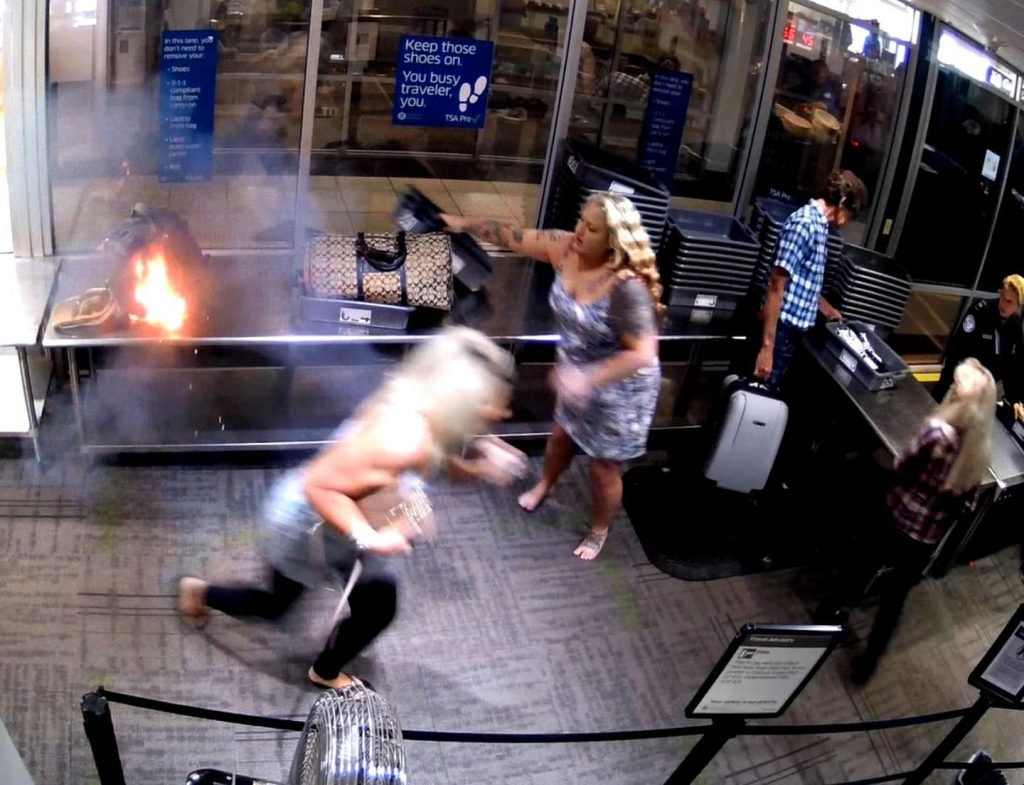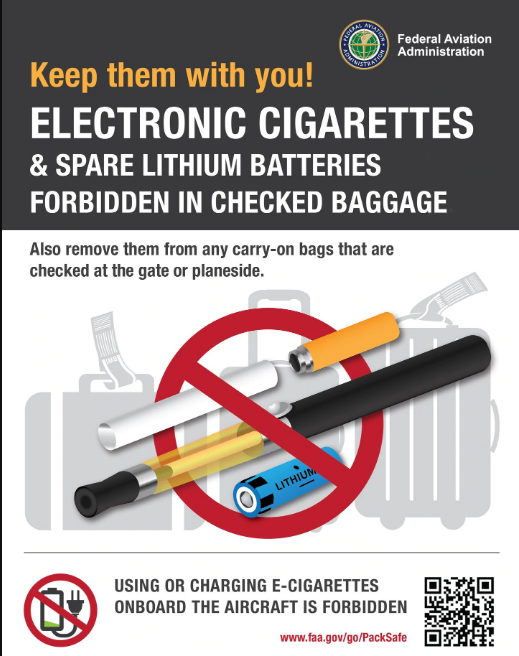When an e-cigarette battery started smoldering on a flight to Los Angeles in July 2017, a SkyWest flight attendant threw it into an ice bucket before shoving it into a fire containment bag. In Denver, two months later, a carry-on bag with four vaping batteries “caught fire on the boarding bridge,” and firefighters were called to put it out, according to the Federal Aviation Administration.
In March, Southwest Airlines employees had to pull a smoking suitcase containing e-cigarette batteries from a plane’s cargo hold in San Diego. Adjacent bags were damaged, as was the plane, which was temporarily taken out of service, according to the FAA.
E-cigarettes and the rechargeable lithium-ion batteries that power them have caused smoke or fire incidents on planes or at airports more than 30 times in three years, according to an FAA database.
In Feb. 2018, Federal Aviation Administration technicians ran lithium battery tests to learn how flight attendants can fight high energy fires. (Federal Aviation Administration)
But the e-cigarettes are part of a broader problem, data shows. Passengers in the United States bring an estimated 2.3 billion electronic devices on planes each year, and safety experts say federal regulators have struggled to keep up with the deluge, often deferring to airlines to manage potential dangers.
In addition to the e-cigarette incidents, the FAA recorded more than 65 other cases of smoking, sparking and flaming lithium-ion batteries in laptops, tablets, phones and other devices, including power packs, drill batteries and rechargeable socks, according to a Washington Post analysis of FAA data, which the agency acknowledged is incomplete.
“We think that’s a pretty significant threat,” said Mark Millam, vice president of technical programs at the Flight Safety Foundation and a former safety chief at Northwest Airlines. “It’s gone from one to multiple devices that most passengers are carrying on. You don’t know where all these things are coming from and what’s in them and how legitimate they are.”
The Post analysis covers the three-year period through Aug. 1, 2019, the latest data available. The FAA took the rare step of banning fire-prone Samsung Galaxy Note 7 smartphones on Oct. 15, 2016.
Some advocates — and even some inside the airline industry — say federal regulators have not been aggressive enough in addressing the risks.
An FAA advisory group said last year that the agency’s guidance for flight crews in fighting fires caused by electronic devices is “inadequate and outdated.” It said better training is needed to manage threats from burning batteries, including potentially toxic and flammable gases and smoke that could obscure pilots’ vision.
“So far, we’ve been lucky nothing’s happened,” said Charles Leocha, president of the advocacy group Travelers United. “I just don’t think the FAA has caught up with the threat.”
‘Up to the Individual Airlines’
Numerous laptops or their batteries have been recalled by their makers because of the possibility they could overheat and catch fire, including those from Apple, Toshiba, Lenovo and Sony, according to the U.S. Consumer Product Safety Commission (CPSC).
But while the FAA broadly prohibits hazardous devices, it has not barred specific laptops.
“The hazardous materials regulations prohibit passengers from bringing on board ‘batteries and battery-powered devices which are likely to create sparks or generate a dangerous evolution of heat, unless packaged in a manner which precludes such an occurrence,’ ” the agency said in a statement.
“It’s up to the individual airlines to determine whether a device is likely to ‘create sparks or generate a dangerous evolution of heat,’ and to transmit that information to their passengers,” the FAA said, adding later, “Because of the wide variety of battery issues that can occur, it is important that airlines have the flexibility to assess and address the risks involved in each individual situation.”
Media reports this summer that the FAA had banned hundreds of thousands of recalled 15-inch Apple MacBook Pro laptops from planes were inaccurate, the agency and airline representatives said. And airlines’ responses have been inconsistent. A Delta spokeswoman said the recalled laptops are not permitted, pointing to a policy statement on the airline’s website that “damaged, defective or recalled lithium batteries must not be carried in carry-on or checked baggage.”
Meanwhile, executives at American and United said the recalled laptops can be brought aboard in carry-on bags but not in checked luggage. United customers must keep the devices turned off and unplugged, the airline said. “Part of the responsibility we’re going to place on the customer,” United spokesman Charles Hobart said.

An image taken from security camera video shows an e-cigarette battery in a knapsack that burst into flames at a passenger checkpoint at Yeager Airport in Charleston, W.Va., in June. (Transportation Security Administration/courtesy of TSA)
Flight attendants, ground crews, agents with the Transportation Security Administration and passengers have increasingly become firefighters, scrambling to limit the damage, FAA incident reports show.
When a Frontier Airlines passenger tossed a smoking iPhone into the aisle on a flight to Phoenix last year, “another passenger picked it up and brought it to the lavatory and placed it in the sink and ran water over it then covered it in ice,” according to an FAA report.
The flight was diverted to Tampa, two people were treated for minor burns, and several passengers reported nausea and headaches, the FAA said. Firefighters walked away with “the faulty cell phone and its associated defective charger,” the FAA said.
The year before, an iPhone caught fire after being crunched in a reclining seat on a flight from Spain. Flight attendants put the phone in a fire containment bag.
On a December 2016 flight from Honolulu, “a fire was discovered in an overhead bin,” according to an FAA incident report. The crew used three halon-gas fire extinguishers and two more filled with water to douse the flaming laptop that caused it.
Many of the burning battery incidents took place on the ground, such as when a woman ran off a plane in Oakland, Calif., because an e-cigarette burned a hole in her purse. Another erupted in a passenger’s pocket in Las Vegas, sending a man to the hospital.

The e-cigarette battery burns at the checkpoint. (Transportation Security Administration/courtesy of TSA)
But about a quarter of the incidents involving e-cigarettes, and half of those involving other electronics, happened in the air, the FAA data shows, elevating safety concerns.
“Just one fire incident poses a high risk of death,” serious injury or destruction of property, the U.S. Transportation Department and the FAA said in their 2016 emergency order banning the Samsung Note 7. “This risk is magnified when the fire or evolution of heat occurs aboard an aircraft during flight.”
To reduce the risk of “serious harm to the traveling public,” the Transportation Department banned e-cigarettes from checked bags in 2015 “because the devices are capable of generating extreme heat and an incident can result in the ignition of nearby contents,” according to a regulatory filing.
The Transportation Department cited “two near misses for the safety of aviation passengers” — a fire in a checked bag before a flight from Boston in 2014 and another in January 2015 in a baggage area in Los Angeles.
Better to bring the devices into cabins because fires there can “be immediately identified and mitigated” by flight attendants, the department said. (Federal regulations bar passengers from putting spare lithium-ion or lithium metal batteries for other electronics in their checked luggage for the same reasons.)
But enforcement has been lax, and passengers continue to disregard the checked-luggage ban, interviews and incident reports show.
A flaming checked bag scorched the floor of an American Airlines plane before takeoff in St. Kitts in March. Another, in May on a belt loader in Baltimore, had to be extinguished by firefighters. Last year, a burning bag rumbled around the carousel in Harrisburg, Pa., after a flight, according to the FAA.
In several recommendations last year, the FAA advisory group, the Air Carrier Training Aviation Rulemaking Committee, called on the agency to update its advice to airlines on dealing with fires caused by batteries. The group said training should be enhanced on “the critical importance of maintaining aircraft control” during incidents, given the danger of toxic fumes and smoke.
Flight-planning computers used by pilots also pose an underappreciated risk, the group said. If they overheat in the cockpit, or smoke from elsewhere isn’t cleared fast enough, “pilots may be unable to see their flight instruments.”
In addition, there are no federal test standards for the containment bags some airlines use for burning devices, the group said, leaving airlines dependent on safety assertions by vendors.
“High-energy” chemical fires can happen when a battery short-circuits, is improperly charged or is damaged, the group noted. As batteries get more powerful, so do the resulting fires, “potentially resulting in aircraft structural damage,” the group said.
An FAA field demonstration showed burning batteries can “quickly generate sufficient flammable gas in the small space inside an overhead bin to cause an explosion,” the group said. In another test, an overheating laptop battery “projected flaming matter” onto a passenger dummy, setting its clothes alight.
The FAA said it has “continued to work collaboratively with the industry” through the advisory group and is working “to update our guidance and develop training media for the industry,” which it expects to release for public comment by early 2020.
Aviation’s First Responders
Airlines vary widely in how well they prepare flight crews to fight fires, according to a 2017 FAA report.
“Some programs comply with regulatory requirements by providing the minimum amount of training required with one-time emergency drills that can hardly be considered ‘realistic,’ ” the report said, while others “provide annual theoretical and practical training in the most realistic environments.”
About two-thirds of flight attendants surveyed said their practical training in fighting fires was “too short,” according to the report.
“Fire on board is extremely concerning,” said Taylor Garland, spokeswoman for the Association of Flight Attendants-CWA.
A key issue for “aviation’s first responders” is making sure there are enough flight attendants on board to quickly address all emergencies, fires included, since airlines generally set their staffing at the minimum level required by regulators, Garland said.
If e-cigarettes are found to pose an increased likelihood of fire compared with other electronics, “then the FAA should be setting a standard there,” she said.
But the union has not called for a ban. “Lithium-ion batteries are part of almost everything we touch at this point in life, and there are some realistic components about how you deal with that,” particularly on a plane with 200 passengers, each with two or three devices, Garland said.
Flight crews have been able to handle nearly all of the e-cigarette incidents during flights in recent years without diverting the plane, according to FAA data.
They dealt with smoking bags on flights from London, Las Vegas and Columbus, Ohio, a smoking battery in a passenger’s pocket en route to Denver, and a charred bag headed for Florida, among others. Flight attendants often dumped the devices into containment bags.
After a passenger saw his overheating e-cigarette smoking on a flight to Indianapolis in December 2016, an American Airlines crew “used fire extinguishers to extinguish” the device, and the flight was diverted to Little Rock.
The FAA noted that “current requirements for e-cigarettes state that spare batteries should be protected so as to prevent short circuits.” But those rules are sometimes ignored, such as on a 2017 flight when an “unprotected battery” was tossed into a small bag with jewelry, according to an FAA incident report.
Some have questioned whether e-cigarettes should be allowed on planes at all.
“It just seems like a bad idea until we figure out what’s going on, why they’re exploding,” said Matthew E. Rossheim, a public health expert and assistant professor at George Mason University.

An FAA notice for passengers. The agency says “banning e-cigarettes from cabins could have the unintended consequence of passengers putting them in their checked luggage,” making it harder for flight crews “to be informed and mitigate any safety concerns.” (Federal Aviation Administration)
Rossheim and his colleagues estimated in a study last year that 2,035 people went to U.S. emergency rooms to treat e-cigarette explosion and burn injuries from 2015 to 2017.
A review of a CPSC database covering cases in 2018 shows the severity of ongoing injuries.
In June, a 44-year-old man’s vape pen exploded in his pocket at a motel, causing second-degree burns on his penis, according to an account filed with the commission. Eight days later, a 38-year-old heard a “whooshing” sound when his device caught fire, burning his thigh. Then, two days later, another explosion and chemical burn, this time on a 28-year-old’s upper leg.
“If it happens in somebody’s pocket while they’re on an airplane packed with people, it could result in severe injuries, not only to the person whose pocket it’s in but all the people who are around and in range of the blast,” Rossheim said.
Market leader Juul says its devices are safe to carry on planes.
“Our captive batteries cannot be removed or altered by the consumer and have limited charging capacity, which mitigates the risks associated with a removable battery. JUUL device batteries also store a fraction of the energy of common open-system vaporizers,” the company said in a statement.
But there are numerous competitors, and many users modify the devices and use aftermarket replacement batteries.
Millam, of the Flight Safety Foundation, said banning broad classes of devices is an overly simplistic approach. “It’s a little bit more complicated than just saying, ‘My e-cigarette turned black — should we ban all e-cigarettes?’ ”
For airlines, “usually this comes down to a risk assessment and calculation,” he said, including two questions: “How often is that sort of thing going to cause problems?” and “What is its potential to ignite something around it?”
Continuing to gather information to see whether a clear case emerges, as has been done in the past, makes sense, he said. Airlines have banned hoverboards and restricted “smart” bags, which are equipped with batteries to recharge yet more batteries.
The FAA said “banning e-cigarettes from cabins could have the unintended consequence of passengers putting them in their checked luggage,” making it harder for flight crews “to be informed and mitigate any safety concerns.”
United spokesman Hobart said the airline has a range of mitigation strategies in case of any problem, including using containment bags or diverting an aircraft if need be.
“We have some of the best-trained crew members in the business,” Hobart said. “If it’s not safe to fly, we’re not going to do it.”
*This blog post first appeared on https://www.washingtonpost.com






